CIVIL WAR SURGEON IMAGES
The De Gregoris
Image collection
The original source
of this collection of Civil War CDV's is Civil War surgeon, Charles
Henry Alden, Brigadier General, Medical Corps, U.S. Army
Search DeGregoris Index by:
Page: 8
This
collection of CDV's has NOT been researched yet and there ARE
errors and omissions. Any help in supplying information or sources on the
individuals would be greatly appreciated.
(Click on all images to
enlarge)
|
AD 8a
William H.
Pancoast, M.D., 1861
William Henry, was a
surgeon, born in Philadelphia, Pennsylvania, 16 October,
1835, graduated at the Jefferson medical college in 1856,
studied for three years in London, Paris, and Vienna, and on
his return established himself in practice in Philadelphia,
and acquired a high reputation as a bold, rapid, and skilful
operative surgeon, conservative in treatment and seldom
mistaken in diagnosis. He served in the Union Army as
an Assistant Surgeon.
|
 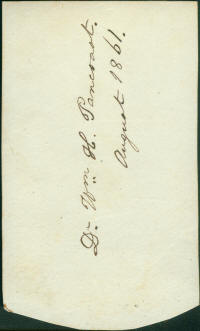 |
AD 8b
Dr. Mary E.
Walker, Civil War doctor
Mary Edwards Walker (November 26, 1832
– February 21, 1919) was an American feminist, abolitionist,
prohibitionist, alleged spy, prisoner of war and surgeon.
She is also the only woman ever to receive the Medal of
Honor.
Prior to the American Civil War she earned her medical
degree, married and started a medical practice. The practice
didn't do well and she volunteered with the Union Army at
the outbreak of the American Civil War and served as a
female surgeon. She was captured by Confederate forces after
crossing enemy lines to treat wounded civilians and arrested
as a spy. She was sent as a prisoner of war to Richmond,
Virginia until released in a prisoner exchange.
After the war she was approved for the United States
military's highest decoration for bravery, the Medal of
Honor, for her efforts during the war. She is the only woman
to receive the medal and one of only eight civilians to
receive it. Her medal was later rescinded based on an Army
determination and then restored in 1977.
|
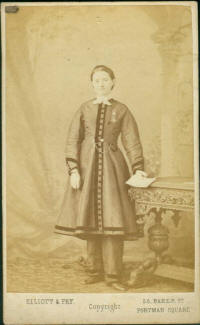 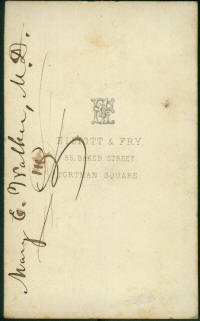 |
AD 8c
A. C. Bergen, U.S.A.
Surgeon
No information |
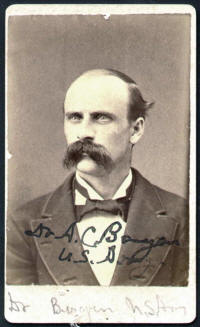 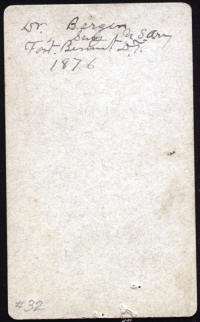 |
AD 8d
Benjamin F.
Gibbs, U.S.N.
Surgeon
Assistant Surgeon, 12 November, 1858. Passed Assistant Surgeon, 22 May,
1862. Surgeon, 22 May, 1862. Medical Inspector, 17 March, 1876. Died 9
September, 1882.
|
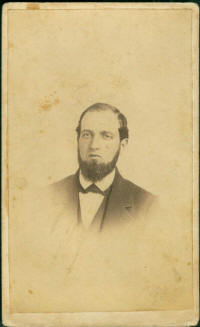  |
AD 8e
Dr. Emile Blaise Gardette,
Dentist, M.D.
Emile B. Gardette, M.D. was a graduate of
Jefferson Medical College in the Class of 1838. Born in 1803 in
Philadelphia, he was first
trained in dentistry by his father, Jacques Gardette (1756-1831), who
practiced in Philadelphia for more than 45 years, having started in
1784. Emile, was brought up in the professional
tradition of dentistry under the preceptor system.
He was a member of the Jefferson Board in 1856, and assumed the
Presidency of the Board on May 15, 1875 |
 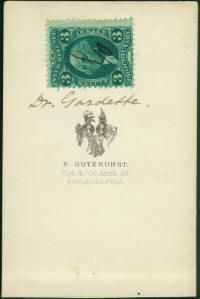 |
AD 8f
Dr. George Pepper
Norris
No information |
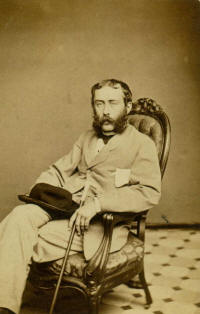 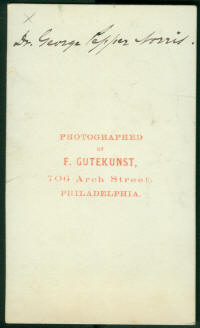 |
AD 8g
Elbert J. Clark, U.S.A.
Surgeon
Dr. Elbert J. Clark was a New Yorker who
moved to Illinois (near Rockford) and served as a private in the Civil
War. He later attended medical training in Chicago; became contract
surgeon and served at a couple of the Indian agencies in Dakota. During
the 1876 campaign he was assigned to the supply depots and camp
hospitals at Rosebud, Powder River and Glendive.
|
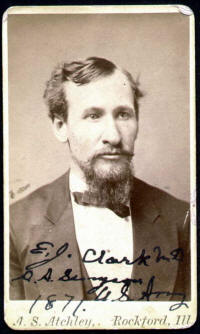  |
AD 8h
J. J. Sowerby, U. S.
N. Surgeon
Acting Assistant Surgeon, 5 November, 1862. Acting
Passed Assistant Surgeon, 12 April, 1865. Honorably discharged 18 July,
1868. Acting Passed Assistant Surgeon, 5 December, 1873. Honorably
discharged 30 June, 1879.
|
 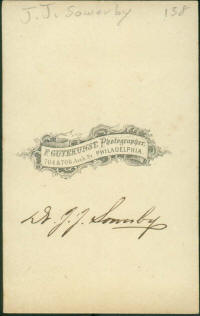 |
|
AD 8i Aaron Ivins Comfort, M. D.,
Aaron Comfort; born on March 4th, 1827, in
Penn's
Manor, Bucks county, Pennsylvania. After having graduated at Williston
Seminary, East Hampton,
Massachusetts. Subsequently, entered Amherst College, Massachusetts.
He graduated in medicine at the University of Pennsylvania in the class
of 1860. After graduating he was an assistant demonstrator of anatomy at
his alma mater, and at the same time he became the attending physician,
and consulting
physician to the Southern dispensary in the Moyamensing district of
Philadelphia as well as
attending, and consulting accoucheur, in the Philadelphia
Lying-in Charity.
February, 1862, he entered the army as an acting assistant surgeon of the United States army, and was
assigned to duty with troops in the field,. The Anderson troops, a
company of volunteer cavalry acting as Gen. D. C. Buell's escort, and,
subsequently, in 1862, he was assigned to duty as the only
medical officer, with the Fourth Regiment, United States cavalry, until
the 9th of June, 1863. As medical officer he was present at the battle of Pittsburg
Landing, Tennessee; siege of Corinth, Mississippi; battle of Perryville,
Kentucky, and of Murfreesboro, Tennessee, at which battle he rode in
person with that regiment in its now historic charge. While on the battlefield, during the engagement,
and in search of a wounded officer, he captured a Confederate soldier,
disarmed him and made him a prisoner of war. During the first half of
1863 he was in a charge of the Fourth regiment, United States cavalry,
at Snow Hill, Tennessee, in a charge of that regiment at Franklin,
Tennessee. During August and several subsequent months he was on duty at
the United States general hospital at Chester, Pennsylvania. In the
spring of 1864 he accepted from President Lincoln a commission as
assistant surgeon, United States volunteers, having previously
passed a satisfactory examination by a board of medical officers of the
regular army. As
assistant surgeon of volunteers he was during part of the spring of 1864
on duty with troops in the field. During the summer and autumn of that
year he was in charge of a small-pox hospital; and also a post
hospital at Columbia, Tennessee. At the advance of the Confederate
General Hood, upon Nashville, when it seemed impossible to prevent the
sick and wounded, in the field hospital at Columbia, Tennessee from
falling into the hands of the enemy, he was detailed to remain "in
charge" of the sick and wounded; and, but for the fact that they were
subsequently removed under cover of the night, he, with them, would have
been made a prisoner of war. He was present at the battle of
Nashville. He was on duty at the Cavalry Corps hospital, at Gallatin,
Tennessee, during the greater part of January and February,
1865. During the spring and the greater part of the summer of that year
he was "surgeon in charge" of Hospital No. 16 at Nashville, which had a
capacity of four or five hundred beds, and a staff of five or six
medical officers. After the close of the war, when the general hospitals
were closed, he was ordered to sell, at auction, the unserviceable
property of Hospitals No. 8. and No. 16, and of one or two others, and
the sum of several thousand dollars, realized there from, reverted to the
treasury of the United States. During the
greater part of the summer and autumn of 1865 he was in charge of Post
Hospital at Clarksville, Tennessee. On the 3rd of November, 1865, he was
mustered out of the service with the brevet rank of captain of
volunteers, but he was assigned to duty as acting assistant surgeon,
United States army, at the headquarters of Major-General George H.Thomas at Nashville, and at once made post surgeon, or "physician in
attendance upon the officers and their families."
From 1866 to 1892 Dr. Comfort was with detachments of the army stationed
at various forts on the frontier,having visited nearly every territory in the west, traveled over the
plains with the soldiers in pursuit of hostile Indians, in his capacity
of assistant surgeon of the army, and as such rendered much service.
There is scarcely a fort from the Dakotas to the Indian Territory and
Arizona where he has not been stationed, and scarcely a trail over the
vast territory of the far west that he has not followed. |
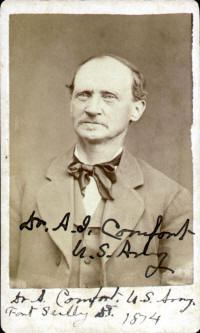 |
Continue via:
|
1 |
2 |
3 |
4 |
5 |
6 |
7 |
8
|
If you have any
Civil War images for sale, north or south,
please
contact us as we are constantly adding to this collection.
Search DeGregoris Index by:
Written permission is required for use of any image in any form
of publication.
Sale or reproduction of any image is strictly prohibited.
|
